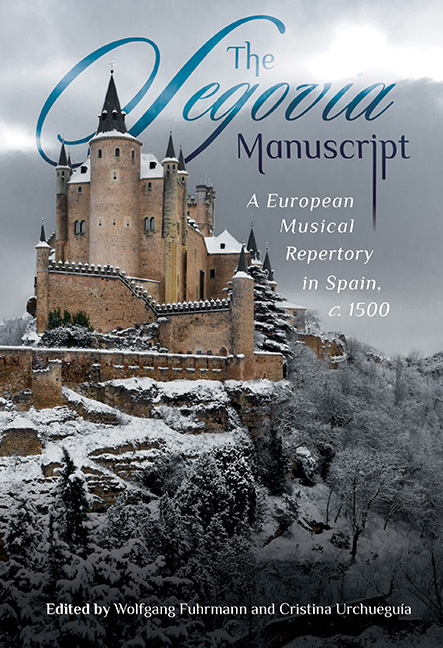Book contents
- Frontmatter
- Contents
- List of Illustrations
- Notes on Contributors
- Abbreviations
- Preambulum: A Source in Segovia
- 1 In Search of Origins: The Afterlife of a Renaissance Manuscript
- 2 New Light on the Segovia Manuscript: Watermarks, Foliation, and Ownership
- 3 Segovia's Repertoire: Attributions and Datings (with Special Reference to Jacob Obrecht)
- 4 What Was Segovia For?
- 5 The Latin Texts of the Segovia Manuscript
- 6 The Segovia Manuscript as Chansonnier
- 7 The Segovia Manuscript: Another Look at the ‘Flemish Hypothesis’
- 8 The Segovia Manuscript: Speculative Notes on the Flemish Connection
- 9 The Written Transmission of Polyphonic Song in Spain c. 1500: The Case of the Segovia Manuscript
- 10 Inventory of Segovia, Archivo Capitular de la Catedral, MS s.s.
- Bibliography
- Index of Compositions
- General Index
- Miscellaneous Endmatter
7 - The Segovia Manuscript: Another Look at the ‘Flemish Hypothesis’
Published online by Cambridge University Press: 29 March 2020
- Frontmatter
- Contents
- List of Illustrations
- Notes on Contributors
- Abbreviations
- Preambulum: A Source in Segovia
- 1 In Search of Origins: The Afterlife of a Renaissance Manuscript
- 2 New Light on the Segovia Manuscript: Watermarks, Foliation, and Ownership
- 3 Segovia's Repertoire: Attributions and Datings (with Special Reference to Jacob Obrecht)
- 4 What Was Segovia For?
- 5 The Latin Texts of the Segovia Manuscript
- 6 The Segovia Manuscript as Chansonnier
- 7 The Segovia Manuscript: Another Look at the ‘Flemish Hypothesis’
- 8 The Segovia Manuscript: Speculative Notes on the Flemish Connection
- 9 The Written Transmission of Polyphonic Song in Spain c. 1500: The Case of the Segovia Manuscript
- 10 Inventory of Segovia, Archivo Capitular de la Catedral, MS s.s.
- Bibliography
- Index of Compositions
- General Index
- Miscellaneous Endmatter
Summary
Although the various types of paper used in the Segovia choirbook have not been securely dated, it is clear from the common related watermark they share that the manuscript must have been compiled in Spain. In the late fifteenth century that watermark – a raised hand surmounted by a five-petalled flower – was almost as common in Spanish paper manuscripts and prints as it was rare in northern European sources. Yet here is the odd and well-known paradox about the Segovia choirbook: while the manuscript is unquestionably of Spanish origin, and while it contains two gatherings devoted, respectively, to Castilian songs and music by Juan de Anchieta, in almost every other respect it looks like a regional western Flemish source.
Much of Segovia's repertory can only have originated in Flanders, or at least in the Southern Netherlands, and is not otherwise known to have enjoyed international transmission. The manuscript offers unique glimpses, for example, into the compositional activities of Jacob Obrecht in Bruges during the late 1480s – including his autobiographical motets Mille quingentis and Inter preclarissimas virtutes, not to mention his numerous songs on Flemish texts. Another superlative Flemish composer for whom the Segovia choirbook is a uniquely important source is Matthaeus Pipelare. It transmits, amongst others, that breathtaking masterpiece by Pipelare that must sadly languish under the generic title Missa Sine nomine (fols. 54v–63r), as well as the only known copy of his middle Dutch song Morkin ic hebbe ter scolen gheleghen. While we do not know anything about Pipelare's life except for the two years he spent in ‘s-Hertogenbosch (1498–1500), the surname Pipelart (or Pippelart) was very common in French Flanders, especially in Lille and St-Omer – two places that are known to have had regular musical exchanges with Bruges. It would be easy to give more examples. There are, for example, the unica by the composer identified by the Segovia scribe as Roelkin (‘Little Roland’), perhaps the Bruges organist Roeland Wreede, who died in 1482. Or the otherwise unknown composer Petrus Elinc – his last name is a contraction of the common Bruges family name Edelinc. Or the only known ascription in any source to Johannes and Carolus Fernandes, two blind brothers who were Bruges natives.
- Type
- Chapter
- Information
- The Segovia ManuscriptA European Musical Repertory in Spain, c.1500, pp. 193 - 214Publisher: Boydell & BrewerPrint publication year: 2019



